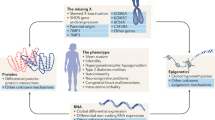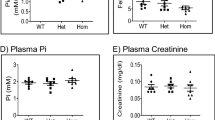Abstract
One in 10,000 children develops Wilms' tumour, an embryonal malignancy of the kidney1. Although most Wilms' tumours are sporadic, a genetic predisposition is associated with aniridia, genito-urinary malformations and mental retardation (the WAGR syndrome)2. Patients with this syndrome typically exhibit constitutional deletions involving band p13 of one chromosome 11 homologue3,4. It is likely that these deletions overlap a cluster of separate but closely linked genes that control the development of the kidney, iris and urogenital tract (the WAGR complex). A discrete aniridia locus, in particular, has been defined within this chromosomal segment by a reciprocal translocation, transmitted through three generations, which interrupts 11p13 (ref. 5). In addition, the specific loss of chromosome 11p alleles in sporadic Wilms' tumours has been demonstrated, suggesting that the WAGR complex includes a recessive oncogene6–9, analogous to the retinoblastoma locus on chromosome 13 (ref. 10). In WAGR patients, the inherited 11p deletion is thought to represent the first of two events required for the initiation of a Wilms' tumour, as suggested by Knudson from epidemiological data11. We have now isolated the deleted chromosomes 11 from four WAGR patients in hamster–human somatic cell hybrids, and have tested genomic DNA from the hybrids with chromosome 11-specific probes. We show that 4 of 31 markers are deleted in at least one patient, but that of these markers, only the gene encoding the β-subunit of follicle-stimulating hormone (FSHB) is deleted in all four patients. Our results demonstrate close physical linkage between FSHB and the WAGR locus, suggest a gene order for the four deleted markers and exclude other markers tested from this region. In hybrids prepared from a balanced translocation carrier with familial aniridia5, the four markers segregate into proximal and distal groups. The translocation breakpoint, which identifies the position of the aniridia gene on 11p, is immediately proximal to FSHB, in the interval between FSHB and the catalase gene.
This is a preview of subscription content, access via your institution
Access options
Subscribe to this journal
Receive 51 print issues and online access
$199.00 per year
only $3.90 per issue
Buy this article
- Purchase on Springer Link
- Instant access to full article PDF
Prices may be subject to local taxes which are calculated during checkout
Similar content being viewed by others
References
Matsunaga, E. Hum. Genet. 57, 231–246 (1981).
Miller, R. W., Fraumeni, J. F. Jr & Manning, M. D. New Engl. J. Med. 270, 922–927 (1964).
Riccardi, V. M., Sujansky, E., Smith, A. C. & Francke, U. Pediatrics 61, 604–610 (1978).
Francke, U., Holmes, L. B., Atkins, L. & Riccardi, V. M. Cytogenet. Cell Genet. 24, 185–192 (1979).
Simola, K. O. J., Knuutila, S., Kaitila, I., Pakola, A. & Pohja, P. Hum. Genet. 63, 158–161 (1983).
Koufos, A. et al. Nature 309, 170–172 (1984).
Orkin, S. H., Goldman, D. S. & Sallan, S. E. Nature 309, 172–174 (1984).
Reeve, A. E. et al. Nature 309, 174–176 (1984).
Fearon, E. R., Vogelstein, B. & Feinberg, A. P. Nature 309, 176–178 (1984).
Cavenee, W. K. et al. Nature 305, 779–784 (1983).
Knudson, A. G. Jr & Strong, L. C. J. natn. Cancer Inst. 48, 313–324 (1972).
Grzeschik, K. H. & Kazazian, H. H. Jr Cytogenet. Cell Genet. 40, 179–205 (1985).
Junien, C. et al. Ann. Genet. 23, 165–168 (1980).
Bruns, G. A. P. et al. Am. J. hum. Genet. 36, 25S (1984).
Michalopoulos, E. E. et al. Hum. Genet. 70, 157–162 (1985).
Schroeder, W. T. et al. Am. J. hum. Genet. 37, A173 (1985).
van Heyningen, V. et al. Proc. natn. Acad. Sci. U.S.A. 82, 8592–8596 (1985).
NIGMS Human Genetic Mutant Cell Repository Catalog of Cell Lines (NIH Publ. 85-2011, 1985).
Bader, J. L. et al. Proc. Am. Ass. Cancer Res. 20, 210 (1979).
Khan, M. P. Archs Biochem. Biophys. 145, 470–483 (1971).
Jeffreys, A. J. Cell 18, 1–10 (1979).
Gusella, J. F. et al. Proc. natn. Acad. Sci. U.S.A. 77, 2829–2833 (1980).
Punnett, H. H. et al. Pediat. Res. 17, 217A (1983).
Beck, A., Velluci, V. & Curry, K. DNA 4, 76 (1985).
Watkins, P. C. et al. DNA (submitted).
Rogler, C. E. et al. Science 230, 319–322 (1985).
Turleau, C. et al. Clin. Genet. 26, 356–362 (1984).
Hittner, H. M., Riccardi, V. M., Ferrell, R. E., Borda, R. R. & Justice, J. Jr Am. J. Ophthal. 89, 531–539 (1980).
Riccardi, V. M. et al. J. Pediat. 100, 574–577 (1982).
Ferrell, R. E., Chakravati, A., Hittner, H. M. & Riccardi, V. M. Proc. natn. Acad. Sci. U.S.A. 77, 1580–1582 (1980).
Arias, S., Rolo, M. & Gonzalez, N. Cytogenet. Cell Genet. 37, 401 (1985).
Lewis, W. H. et al. Hum. Genet. 71, 249–253 (1985).
Willard, H. F. Am. J. hum. Genet. 37, 524–532 (1985).
Glaser, T. et al. Cytogenet. Cell Genet. 40, 643 (1985).
Gerhard, D. S. & Housman, D. E. Cytogenet. Cell Genet. 40, 640 (1985).
Housman, D. E., Gerhard, D. S., Glaser, T. & Jones, C. Cytogenet. Cell Genet. 40, 656 (1985).
Turleau, C. et al. Hum. Genet. 67, 455–456 (1984).
Narahara, K. et al. Hum. Genet. 66, 181–185 (1984).
Cotlier, E., Rose, M. & Moel, S. A. Am. J. Ophthal. 86, 129–132 (1978).
Codero, J. F., Li, F. P., Holmes, L. B. & Gerald, P. S. Pediatrics 66, 716–719 (1980).
Standing Committee on Human Cytogenetic Nomenclature Cytogenet. Cell Genet. 31, 1–23 (1981).
Schwartz, D. C. & Cantor, C. R. Cell 37, 67–75 (1984).
Collins, F. S. & Weissman, S. M. Proc. natn. Acad. Sci. U.S.A. 81, 6812–6816 (1984).
Yunis, J. J. & Ramsey, N. Am. J. Dis. Childh. 132, 161–163 (1978).
Ledbetter, D. H. et al. Am. J. hum. Genet. 34, 278–285 (1982).
Carlock, L. R. & Wasmuth, J. J. Somat. Cell molec. Genet. 11, 267–276 (1985).
Gusella, J. F. et al. Nature 318, 75–78 (1985).
Athwal, R. S. & McBride, O. W. Proc. natn. Acad. Sci. U.S.A. 74, 2943–2947 (1977).
Kucherlapati, R. S., Baker, R. M. & Ruddle, F. M. Cytogenet. Cell Genet. 14, 362–363 (1975).
Gusella, J. F. thesis, Massachusetts Inst. Technol. (1980).
Shih, C. & Weinberg, R. A. Cell 29, 161–169 (1982).
Bell, G. I., Gerhard, D. S., Fong, N. M., Sanchez-Pescador, R. & Rall, L. B. Proc. natn. Acad. Sci. U.S.A. 82, 6450–6454 (1985).
Faust, P. L., Kornfeld, S. & Chirgwin, J. M. Proc. natn. Acad. Sci. U.S.A. 82, 4910–4914 (1985).
Barker, D., Holm, T. & White, R. Am. J. hum. Genet. 36, 1159–1171 (1984).
Tuan, D., Solomon, W., Ki, Q. & London, I. M. Proc. natn. Acad. Sci. U.S.A. 82, 6384–6388 (1985).
Przepiorka, D. et al. Biochem. biophys. Res. Commun. 120, 493–499 (1984).
Vasicek, T. J. et al. Proc. natn. Acad. Sci. U.S.A. 80, 2127–2131 (1983).
Glaser, T., Gerhard, D., Payne, C., Jones, C. & Housman, D. Cytogenet. Cell Genet. 40, 643 (1985).
Taggart, R. T., Mohandas, T. K., Shows, T. B. & Bell, G. I. Proc. natn. Acad. Sci. U.S.A. 82, 6240–6244 (1985).
Hwang, P. et al. Eur. J. Biochem. 152, 267–274 (1985).
Casey, G., Smith, R., McGillivray, D., Peters, G. & Dickson, C. Molec. cell. Biol. 6, 502–510 (1986).
Su, T. et al. Am. J. hum. Genet. 36, 954–964 (1984).
Freytag, S. O. & Collier, K. J. J. biol. Chem. 259, 12831–12837 (1984).
Ordovas, J. M. et al. New Engl. J. Med. 314, 671–677 (1986).
van den Elsen, P. et al. Proc. natn. Acad. Sci. U.S.A. 82, 2920–2924 (1985).
Southern, E. M. J. molec. Biol. 98, 503–517 (1975).
Francke, U. & Oliver, N. Hum. Genet. 45, 137–165 (1978).
Feinberg, A. P. & Vogelstein, B. Analyt. Biochem. 137, 266–267 (1984).
Denhardt, D. Biochem. biophys. Res. Commun. 23, 641–652 (1966).
Author information
Authors and Affiliations
Rights and permissions
About this article
Cite this article
Glaser, T., Lewis, W., Bruns, G. et al. The β-subunit of follicle-stimulating hormone is deleted in patients with aniridia and Wilms' tumour, allowing a further definition of the WAGR locus. Nature 321, 882–887 (1986). https://doi.org/10.1038/321882a0
Received:
Accepted:
Issue Date:
DOI: https://doi.org/10.1038/321882a0
This article is cited by
-
Experimentally-derived haplotypes substantially increase the efficiency of linkage disequilibrium studies
Nature Genetics (2001)
-
Genomic structure, evolutionary conservation and aniridia mutations in the human PAX6 gene
Nature Genetics (1992)
-
Mouse chromosome 2
Mammalian Genome (1991)
-
Stem cell factor (SCF), a novel hematopoietic growth factor and ligand for c-kit tyrosine kinase receptor, maps on human chromosome 12 between 12q14.3 and 12qter
Somatic Cell and Molecular Genetics (1991)
-
The candidate Wilms' tumour gene is involved in genitourinary development
Nature (1990)
Comments
By submitting a comment you agree to abide by our Terms and Community Guidelines. If you find something abusive or that does not comply with our terms or guidelines please flag it as inappropriate.



